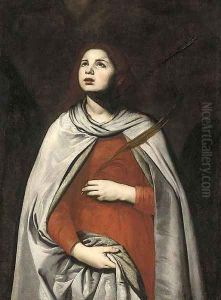Francesco De Rosa (Pacecco De Rosa) Paintings
Francesco De Rosa, known as Pacecco De Rosa, was an Italian painter who was active during the Baroque period. He was born in 1607 in Naples, which at the time was a thriving center for the arts and part of the Spanish Empire. De Rosa was one of the notable artists of the Neapolitan school, which was known for its dramatic use of color and light, much influenced by Caravaggio and his followers.
Pacecco De Rosa's training and early influences came from various sources. He initially apprenticed with his father, Giovanni Domenico De Rosa, who was also a painter. Later, he came under the tutelage of the distinguished painter Massimo Stanzione, who was one of the prominent figures of Neapolitan Baroque art. Under Stanzione, De Rosa's style began to take shape, combining the naturalism and chiaroscuro effects that were characteristic of the Baroque movement with his own personal touch.
Throughout his career, De Rosa developed a reputation for his religious works, which included altarpieces and paintings for local churches and convents. His works often depicted scenes from the life of Christ, the Virgin Mary, and the saints, executed with a rich palette and a strong emphasis on dramatic lighting. However, De Rosa was also known for his mythological and allegorical subjects, which were popular with the aristocratic patrons of the time.
Despite his early promise and talent, Pacecco De Rosa's career was marked by personal struggles and financial difficulties. The plague of 1656, which ravaged Naples and claimed a significant portion of its population, also took De Rosa's life that same year. He died relatively young, and while his works were appreciated, he did not gain the same level of posthumous fame as some of his contemporaries.
Today, Pacecco De Rosa is recognized for his contributions to the Neapolitan Baroque movement, and his works can be found in various museums and collections in Italy and around the world. His paintings are appreciated for their vivid portrayal of religious fervor and the lively depiction of mythological scenes, reflecting the dynamic culture of 17th-century Naples.
